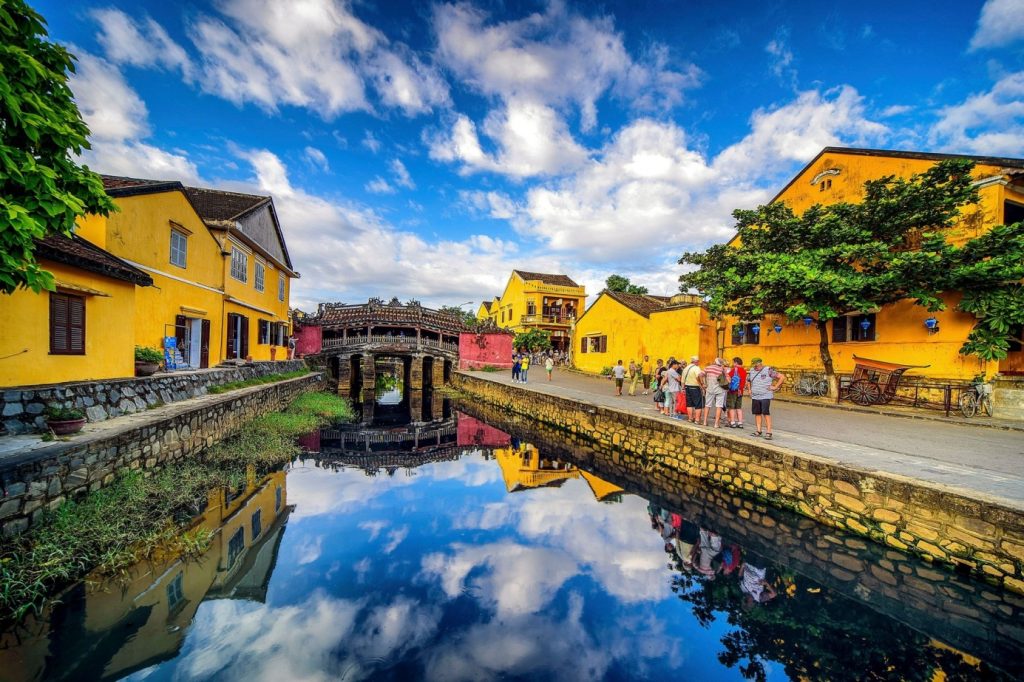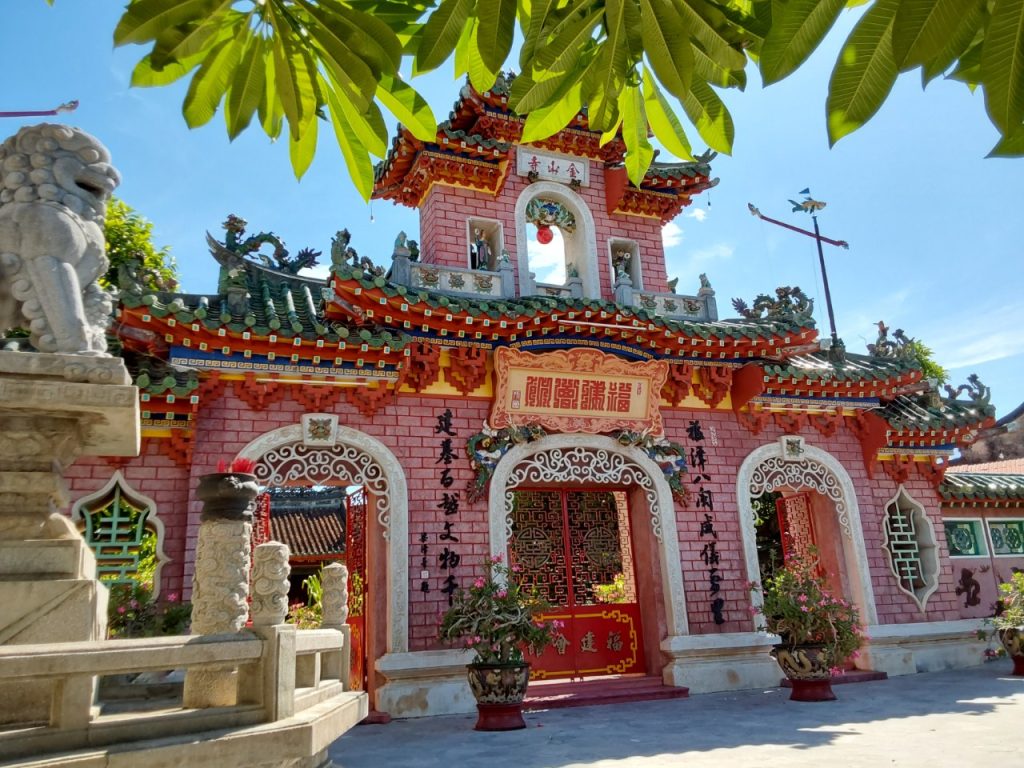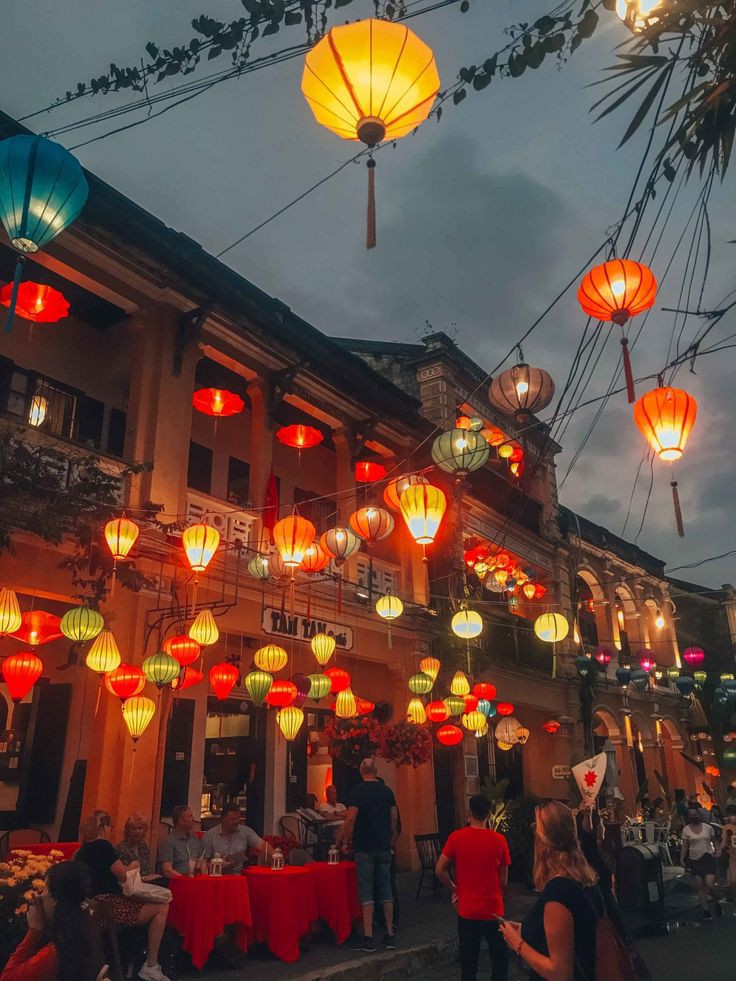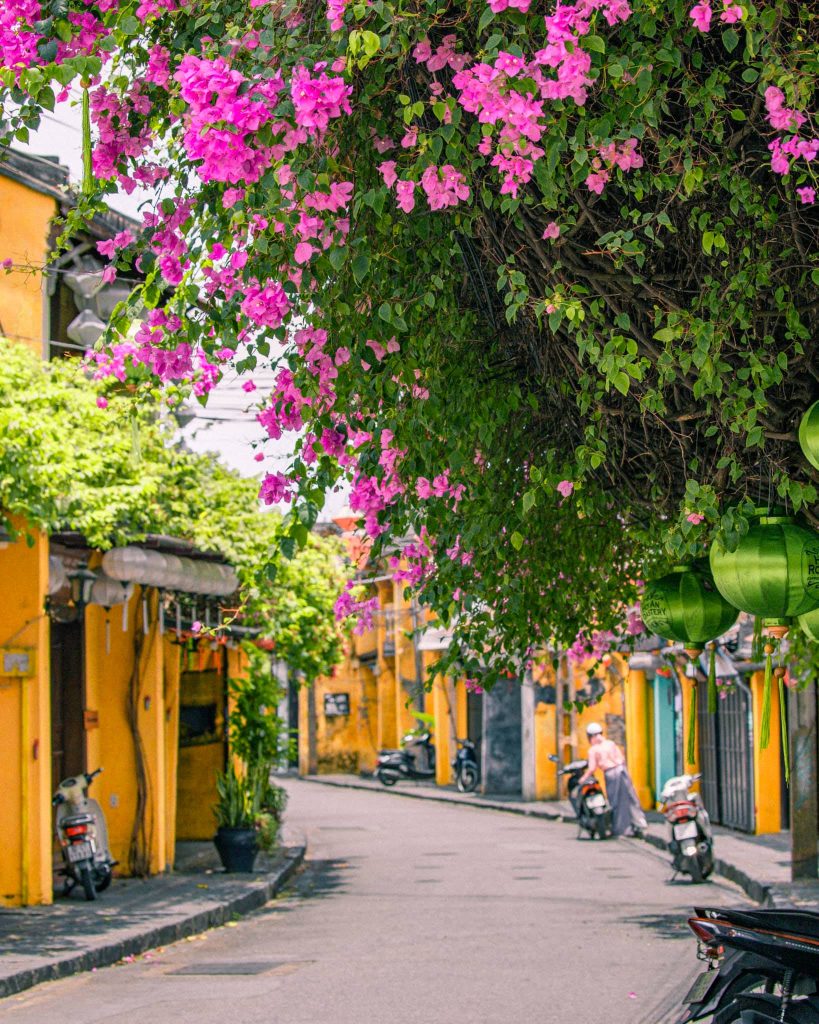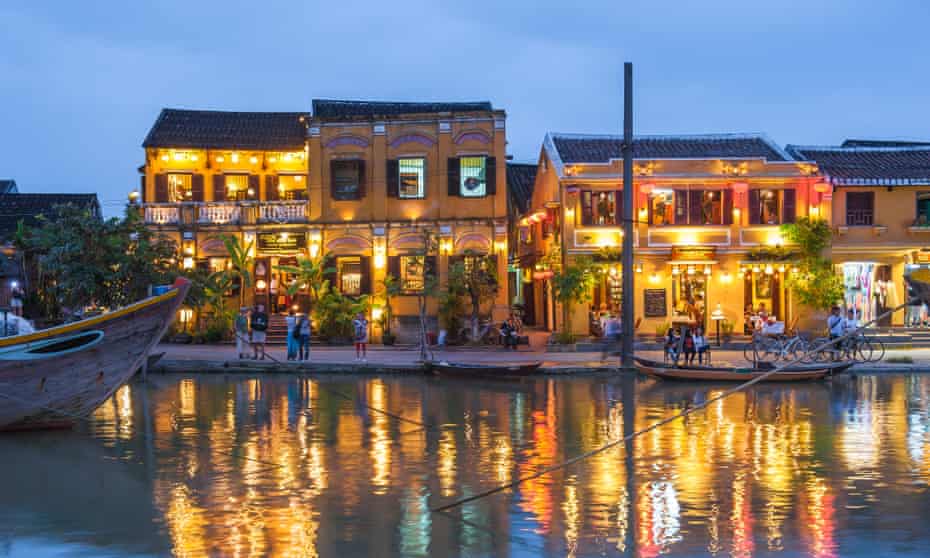Hoi An Ancient Town
About Hoi An Ancient Town
Hội An translates as “peaceful meeting place” from Sino-Vietnamese. In English and other European languages, the town was known historically as Faifo. This word is derived from Vietnamese Hội An phố (the town of Hội An), which was shortened to “Hoi-pho”, and then to “Faifo”. It has also been known as Hải Phố, Hoài Phố, Hội Phố, Hoa Phố, and Haiso, and during the Champa period, it was named Lam Ap Pho.
Hoi An Ancient Town is an exceptionally well-preserved example of a South-East Asian trading port dating from the 15th to the 19th century. Its buildings and its street plan reflect the influences, both indigenous and foreign, that have combined to produce
In 1999 the old town was declared a World Heritage Site by UNESCO as a well-preserved example of a Southeast Asian trading port of the 15th to 19th centuries, with buildings that display a blend of local and foreign influences. According to the UNESCO Impact Report 2008 on Hội An, there are challenges for stakeholders to protect the heritage from tourism. Unique heritage site.
A sunny day in Ancient Town Hoi An
Outstanding Universal Value
Hoi An Ancient town is located in Viet Nam’s central Quang Nam Province, on the north bank near the mouth of the Thu Bon River. The inscribed property comprises 30 ha and it has a buffer zone of 280 ha. It is an exceptionally well-preserved example of a small-scale trading port active in the 15th to 19th centuries which traded widely, both with the countries of Southeast and East Asia and with the rest of the world. Its decline in the later 19th century ensured that it retained its traditional urban tissue to a remarkable degree.
The town reflects a fusion of indigenous and foreign cultures (principally Chinese and Japanese with later European influences) that combined to produce this unique survival.
The town comprises a well-preserved complex of 1,107 timber frame buildings, with brick or wooden walls, which include architectural monuments, commercial and domestic vernacular structures, notably an open market and a ferry quay, and religious buildings such as pagodas and family cult houses. The houses are tiled and the wooden components are carved with traditional motifs. They are arranged side-by-side in tight, unbroken rows along narrow pedestrian streets. There is also the fine wooden Japanese bridge, with a pagoda on it, dating from the 18th century. The original street plan, which developed as the town became a port, remains. It comprises a grid of streets with one axis parallel to the river and the other axis of streets and alleys set at right angles to it. Typically, the buildings front the streets for convenient customer access while the backs of the buildings open to the river allowing easy loading and off-loading of goods from boats.
The surviving wooden structures and street plan are original and intact and together present a traditional townscape of the 17th and 18th centuries, the survival of which is unique in the region. The town continues to this day to be occupied and function as a trading port and center of commerce. The living heritage reflecting the diverse communities of the indigenous inhabitants of the town, as well as foreigners, has also been preserved and continues to be passed on. Hoi An Ancient Town remains an exceptionally well-preserved example of a Far Eastern port.
If you just want to take a chill walk around the old town, enjoy Hoi An’s specialties or take beautiful pictures, there is no entrance fee. However, there are several cultural monuments that require entry tickets:
• Cultural constructions: Quan Cong Temple, Chua Cau Bridge, etc…
• Ancient houses: Phung Hung ancient house, Duc An ancient house, Tan Ky old house, etc…
• Church: Church of the Tran family, Church of the Nguyen family.
• Museums
Hoai River is a tributary of the Thu Bon river which flows across the Ancient Town and connects to other tourist attractions. A chilling boat trip on the Hoai River is a popular activity on tourists’ must-do lists. It is highly recommended that you go to Hoi An Ancient Town at
night as with the lights from the houses, the whole riverbank becomes a glowing fairyland. Visitors can clearly feel the peaceful, gentle, and romantic vibe of Ancient Town Hoi An.
Lanterns released on the Hoai River are also a meaningful ritual as it is to express gratitude to ancestors and wish for a prosperous year. Full moon days (the 1st and 15th of the month according to the lunar calendar) are when “the old town trades its electric lights for traditional colorful lanterns”. Hoai River twinkles with the soft light of the lanterns, while thousands of candlelit paper flowers float across the water at night.
Hoai River is a tributary of the Thu Bon river which flows across the Ancient Town and connects to other tourist attractions. A chilling boat trip on the Hoai River is a popular activity on tourists’ must-do lists. It is highly recommended that you go to Hoi An Ancient Town at night as with the lights from the houses, the whole riverbank becomes a glowing fairyland. Visitors can clearly feel the peaceful, gentle, and romantic vibe of Ancient Town Hoi An.
Lanterns released on the Hoai River are also a meaningful ritual as it is to express gratitude to ancestors and wish for a prosperous year. Full moon days (the 1st and 15th of the month according to the lunar calendar) are when “the old town trades its electric lights for traditional colorful lanterns”. Hoai River twinkles with the soft light of the lanterns, while thousands of candlelit paper flowers float across the water at night.
Japanese Covered Bridge (Chua Cau)
Your trip to Hoi An will be incomplete if you miss out on the Japanese Covered Bridge, one of the most alluring attractions in Hoi An. Also known as the Japanese Temple, the Covered Bridge is located adjacent to Nguyen Thi Minh Khai Street and Tran Phu Street. The bridge is an excellent example of traditional Eastern architecture. Despite being built by Japanese merchants around the middle of the 16th century, through restoration, the Japanese Covered Bridge has become a harmonic architectural combination between Vietnamese, Japanese, and Chinese cultures.
Cantonese Assembly Hall
Built-in 1885, the Cantonese Assembly Hall is located in the center of Hoi An old town. This assembly hall is a harmonious blend of materials of wood and stone. This place conserves many ceramic artifacts, which simulate and document the cultural life of the Cantonese community in Hoi An.
Fujian Assembly Hall
Among the 5 ancient assembly halls, Fujian, located at 46 Tran Phu, is the largest and most well-known. Visitors tend to light large incense rings and often hang wishing paper sheets to pray for health and fortune. The Hall was granted a national historical-cultural relic certification (February 17, 1990), adorning Hoi An ancient urban architecture.
Trieu Chau Assembly Hall
Trieu Chau Assembly Hall was built by the Chaozhou community in 1845 to worship the god Phuc Ba for a safe voyage and smooth sailing. Architectural motifs are decorated according to folk legends, many of which are embossed with porcelain.
Ancient houses
Tan Ky Old House
This was the first house to be honored as a national heritage site and is also frequently visited by various governors. Over centuries, even after the historic flood of 1964, the ancient house remains miraculously intact. The wooden East Asian-inspired decorative patterns in the house are delicately carved, indicating the exchange between different architectural styles.
Phung Hung Old House
The house is completely built of expensive ironwood, bearing a traditional beauty and displaying the owner’s well-off life. Phung Hung Old House is the guardian of the rich knowledge about the merchants’ lifestyle in Hoi An old trading port. This ancient house was granted the certificate of historical-cultural relic in June 1993.
Quang Thang House
Built approximately around 300 years ago, Quang Thang House is definitely one of the oldest houses in Hoi An. Walking in, you can easily notice stunning wood carvings of peacocks and flowers on the walls. Those sculptures are the products of the Kim Bong carpentry village’s craftsmen, who are renowned for their sophisticated craftsmanship of the Hue garden houses.
Tran Family Chapel
The Tran Family Chapel is one of the famous destinations of Hoi An with its well-preserved antiquated garden architecture, exquisite decoration, intricate details, and numerous valuable antique artifacts. The Chapel is a harmonious and unique mix of 3 different architectural styles: Japanese – Chinese – Vietnamese. For the history enthusiasts, a visit to the Tran Family Chapel will be absolutely remarkable as the atmosphere and tradition of history are imbued in the relics of the Tran Family.
Tran Family Chapel – Hoi An
Sacred temples
Quan Cong Temple
Quan Cong Temple, also known as Kong Pagoda, is one of the biggest Hoi An tourist destinations with great spiritual and religious significance. Tourists are captivated by the extraordinary classical Chinese-influenced architecture of the temple. The ancient shrine with a mossy tiled roof has vividly portrayed the traditional charm of cultural heritage in Hoi An.
Quan Cong Temple is located at 24th Tran Phu Street, Hoi An
Ba Mu Pagoda
Since its renovation, Ba Mu Pagoda has become one of the most popular check-in locations. Situated right in the heart of Ancient Town Hoi An, the pagoda is endowed with exquisitely carved golden walls, bunches of flowers blooming with shimmering colors, and a clear lake reflecting the aquarium-blue sky. Blessed with antique charm and open space, the pagoda is the perfect background for visitors to take impressive photos.
Minh Huong Pagoda
Minh Huong Pagoda is a place of ancestor worship for Chinese people living in Hoi An. It is the only remaining Buddhist temple in the heart of the Ancient Town of Hoi An. It preserves substantially intact wooden sculptures carved by the artisans of Hoi An Kim Bong carpentry village.
Minh Huong pagoda carries the cultural and historical significance of Hoi An.
Hoi An Central Market
Unlike the calmness and tranquility of the old town, Hoi An Central Market is a distinct highlight of the ancient town, attracting a large number of tourists thanks to its bustling and lively atmosphere. The Market itself is divided into several areas for fresh seafood, vegetables, fruits, and souvenirs… but perhaps the most appealing place must be the food court. Here, visitors will have the chance to try various delicacies of Central Vietnam cuisine such as Cao Lau, Quang noodles, etc.
Hoi An Central market – a “food paradise”
Museum of Culture
Hoi An Museum of Cultural History is living proof of a once prosperous trading port. Built-in 1989, the museum displays over 212 original artifacts and documents made of diverse materials like ceramics, bronze, iron, wood, paper, etc.
The museum is like a film carefully recording historical events of the heritage land. It continuously keeps track of and witnesses the human, cultural and historical developments of Hoi An Ancient Town since its early days, from when it was a busy harbor to today – when it is a famous tourist destination.
So, after walking around Hoi An Ancient Town, you should visit the museum and immerse yourself in the flow of history to fully embrace Hoi An.
Ceramic Museum
Museum of Trade CeramicsThe Museum of Trade Ceramics is located at 80 Tran Phu Street and was established in 1995, in a restored wooden building, originally built around 1858. The items originating from Persia, China, Thailand, India, and other countries are proof of the importance of Hội An as a major trading port in South East Asia.
Hoi An Street food
Hoi An cuisine is well-known for a good reason, thanks to its traditional and mouth-watering delicacies. Especially, Hoi An street food, which is teeming with rich flavors and appeals to adventurous appetites, will sneak its way into your list of favorite foods in no time.
Are you ready to savor the culinary delights of Hoi An?
Hoi An fantastic cuisine has evolved over time by combining Chinese, French, and Japanese influences, but it remains unique with local recipes and flavorful ingredients. Hoi An street food is considered the most symbolic and rewarding with its classic specialties and reasonable prices. To enrich your food adventure in the cultural city, Vinpearl has rounded up 13 of the finest Hoi An street food and one of the best places to eat them below.
Banh mi – The world-famous Vietnamese street food in Hoi An
Banh mi, meaning “bread,” is a Vietnamese version of a French baguette with balanced ingredients and scrumptious local tastes. Banh Mi is thin and crunchy bread stuffed with various fillings, generally pork, fried eggs, pate or chicken, and homemade tangy sauce. The classic Hoi An Banh Mi is distinctive in that it has a lot of vegetables, such as lettuce, cucumbers, pickled carrots, and coriander. Every bite of a Banh Mi consists of a perfect combination of spicy, salty, sweet, and crispy textures.
Banh Mi has unarguably gained worldwide popularity and local preference thanks to its exquisite flavor, cheapness, and convenience. As the favorite Hoi An street food, Banh mi is found on every street corner in the town. One of the most reputable Banh Mi shops is Banh Mi Phuong, which has obtained approval from food reviewers and travel journalists, notably celebrity chef Anthony Bourdain.
• Average costs: 15.000 ~ 40.000 VND/ a Banh Mi
• Where to eat Banh Mi: Bánh Mì Phượng – 2B Phan Chau Trinh Street, Minh An Ward, Hoi An City
Quang noodles – The best street food Hoi An you cannot afford to miss
Mi Quang (Quang-style noodles) is an exclusive Central Vietnamese noodle dish that originated from Quang Nam province, where Hoi An is a part of it. A typical bowl of Mi Quang contains many ingredients, including flat rice noodles, a little bone broth, slices of pork, beef or chicken, shrimp, and quail eggs. To balance its flavors, the dish can be ordered with rice crackers, fresh vegetables, and herbs like basil, peanuts, mint, and coriander.
Some people may hesitate because of the yellow color of the noodles in Mi Quang. But it comes from turmeric and is totally healthy. Having a bowl of warm Mi Quang is such a great way to start your day in Hoi An city.
• Average costs: 30.000 ~ 45.000 VND/ a bowl
• Where to eat Mi Quang: Dì Hát (Quang Hat Noodles) – 81 Phan Chau Trinh Street, Mi My Quang, a must-eat Hoi An street food, features yellow rice noodles, meat toppings, and vegetables
Cao Lau – The iconic food of Hoi An cuisine
Cao Lau is a renowned noodle specialty invented in Hoi An. It embodies the delicious fusion of Chinese, Japanese, and Vietnamese cuisine. This Hoi An iconic dish includes Japanese udon-like noodles, pieces of roasted pork resembling Chinese Char Siu, raw greens, beansprouts, and crunchy croutons, along with the Hoi An-style special sauce. Locals often mix Cao Lau with lime juice, Vietnamese chili paste, and fresh sliced chili to add extra flavor.
It has been said that the secret recipe of the authentic Hoi An Cao Lau uses water from an ancient mysterious well – Ba Le well, jungle wood ash from Cham islands, and organic herbs from Tra Que gardens. This is the reason why you should not miss out on the unique Cao Lau in Hoi An city.
The origin of Cao Lau’s name also arouses the curiosity of foodies. Cao Lau means “high story” in Vietnamese because back in the 17th century, it was an exclusive dish served to the upper classes who would dine on the upper floors of restaurants. The social hierarchy has been removed in modern times, but people still keep its name as a signature of the Hoi An street food.
• Average costs: 25.000 ~ 44.000 VND/ a bowl
• Where to eat Cao Lau: Bà Bé Cao Lau – Central Market, 19 Tran Phu Street, Cam Chau Ward, Hoi An City
A Hoi An food tour would not be complete without trying Cao Lau
Wonton – A signature dish in Hoi An style
Wonton, known as Hoi An Pizza (Hoanh Thanh Chien in Vietnamese), was first introduced by Chinese traders and adjusted to local taste. The Hoi An Wonton features unwrapped deep-fried wontons topped with some salsa-like mix of shrimp, husked pork, minced onions, vegetables, and different spices. The richness of the dumplings is softened by dipping them in a mixture of chili sauce, soya sauce, and vinegar.
• Average costs: 40.000 ~110.000 VND/ a plate of Wontons
• Where to eat Wontons: Van Loc Restaurant – 27 Tran Phu Street, Minh An Ward, Hoi An City
•Hoi An fried wonton can make a yummy appetizer or a beer snack
Water fern cake – The delicious street food in Hoi An Vietnam
Bánh Bèo (Water Fern Cake) is a small steamed rice cake smothered by an orange sauce of dried shrimp, ground pork, scallions, oil, and rice vinegar. The savory cake is also finished with fish sauce and crispy fried shallots. Vendors often serve a round tray of five tiny cups of Banh Beo and flat teaspoons for customers to scoop the cake out easily.
• Average costs: 2.000 ~ 5.000 VND/ a cup
• Where to eat Water Fern Cake: Bà Bảy (Aunt Bay’s Banh Beo) – 2 Hoang Van Thu Street (on the corner of the old wall), Hoi An City
Water Fern Cake is simple but astoundingly tasteful – a perfect late-afternoon snack for your Hoi An street food tour
Chicken rice – A delectable Hoi An specialty
The origin of Hoi An chicken rice is associated with the famous Hainanese chicken rice brought by Chinese immigrants in Quang Nam Province. Hoi An locals used seasoned pilaf rice and shredded poached chicken as major ingredients and added assorted salads of shredded green papaya and carrots, onions, and herbs to meet the Vietnamese taste.
Hoi An chicken rice also goes with rubbery hard-boiled egg yolk, chicken broth, soy sauce, and chili jam. The fragrant rice is cooked with poached chicken broth, turmeric, and pandan leaves on a wooden stove, giving it an appealing golden yellow color.
• Average costs: 35.000 ~ 40.000 VND/ a plate
• Where to eat Chicken Rice: Cơm gà Bà Buội – Phan Chau Trinh Street, Minh An Ward, Hoi An City
A Hoi An-style chicken rice dish is bursting with an array of colorful ingredients
Grilled pork over vermicelli – A tasty dish in Hoi An street food markets
Bun Thit Nuong (Grilled pork over vermicelli) is slightly different from Bun Cha of Ha Noi. This Hoi An street food basically involves a healthy mix of white vermicelli rice noodles (bún), green chilies, chopped lettuce, cucumber, basil, mint, and peanut-based gravy. The dish is then filled with sweet and peppery pork slices (thịt nướng) grilled over charcoal stoves. Finally, fresh herbs and fish sauce come along with Bun Thit Nuong, which determines this Hoi An food’s delicate texture.
• Average costs: 30.000 ~ 45.000 VND/ a bowl
• Where to eat Bun Thit Nuong: Cô Bảy – Section 5 of Central Market, 19 Tran Phu Street, Cam Chau Ward, Hoi An City
A full appetizing tray of Banh Uot Thit Nuong is served at street restaurants in Hoi An
Vietnamese spring rolls
Fans of Vietnamese food are definitely familiar with the typical favorite – spring rolls (Gỏi cuốn). This Hoi An street food is packed with rice vermicelli, veggies, slivers of meat, and shrimp, before being neatly rolled in a soft rice paper and dunked in fish sauce or peanut sauce. Vietnamese spring rolls are a healthy choice for an appetizer because they taste refreshing and yummy with little oil and almost zero fat.
• Average costs: 5.000 VND/ a roll
• Where to eat Spring Rolls: Ram Spring Roll Restaurant – 33 Cua Dai, Hoi An City
The light and fresh Vietnamese spring rolls are a great option when you have been overeating greasy food
Vietnamese pancake – An unmissable delicacy in the Hoi An food tour
The Bánh Xèo (Vietnamese pancake) is a sophisticated delicacy that can be found all over Vietnam, but its Hoi An version has a characteristic flavor. Banh Xeo features a savory and crispy crepe made of deep-fried rice flour squeezed with coconut milk and turmeric spice powder. The pancake is then dressed with abundant toppings, typically pork, prawns, sliced onions, bean sprouts, garlic chives, and mushrooms.
The proper way to eat a Vietnamese pancake is to wrap it in a sheet of rice paper with some lettuce leaves and herbs before dipping it into fermented peanut sauce or fish sauce. The size of Hoi An Banh Xeo is smaller than that of other versions, which makes it easier to roll up. You can find the pancake at roadside food stalls, local markets, and street restaurants in Hoi An.
• Average costs: 30.000 ~ 40.000 VND/ a plate
• Where to eat Vietnamese Pancake: Bánh Xèo Sông Hoài (Bánh Xèo Cô Anh) – 59/32, 18/8 Street, Minh An Ward, Hoi An City
The Hoi An Banh Xeo has an eye-catching yellow color and melt-in-your-mouth textures
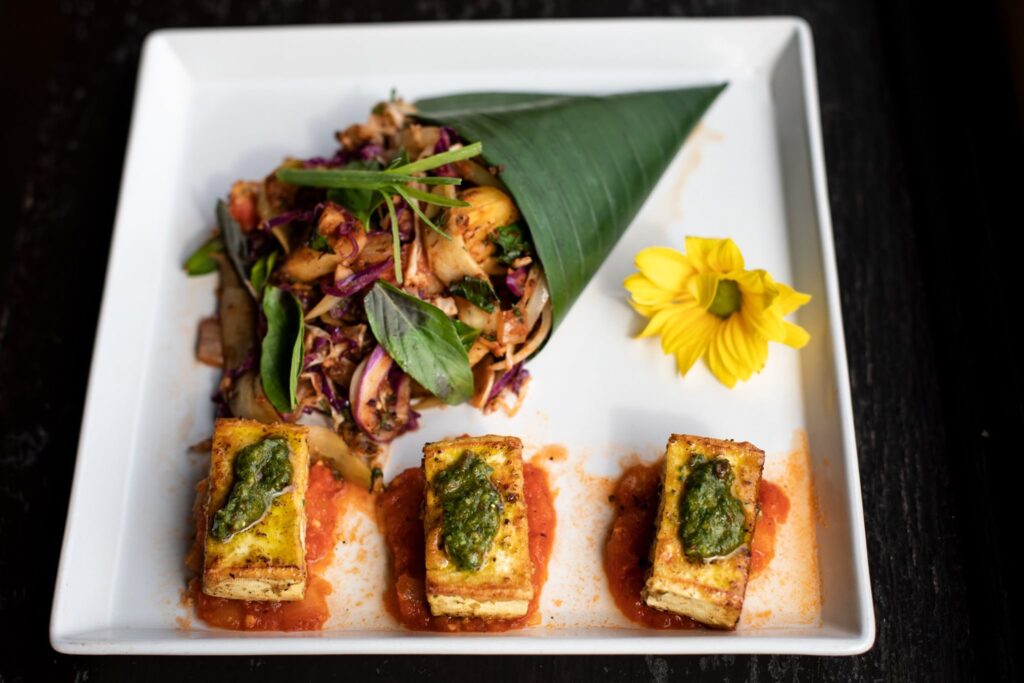
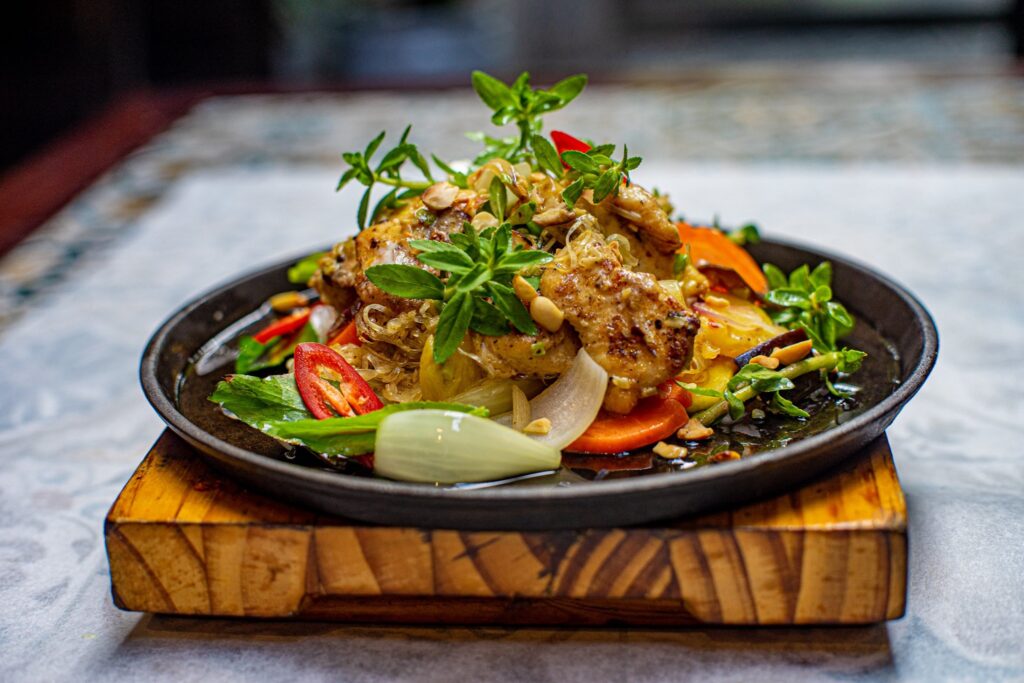
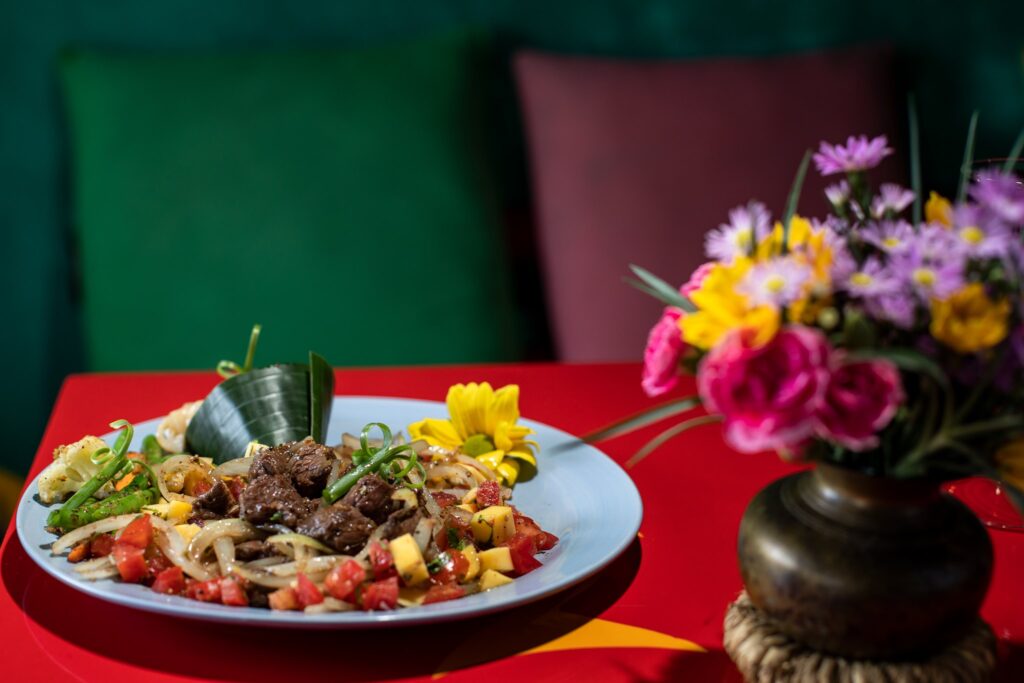

 Tiếng Việt
Tiếng Việt
